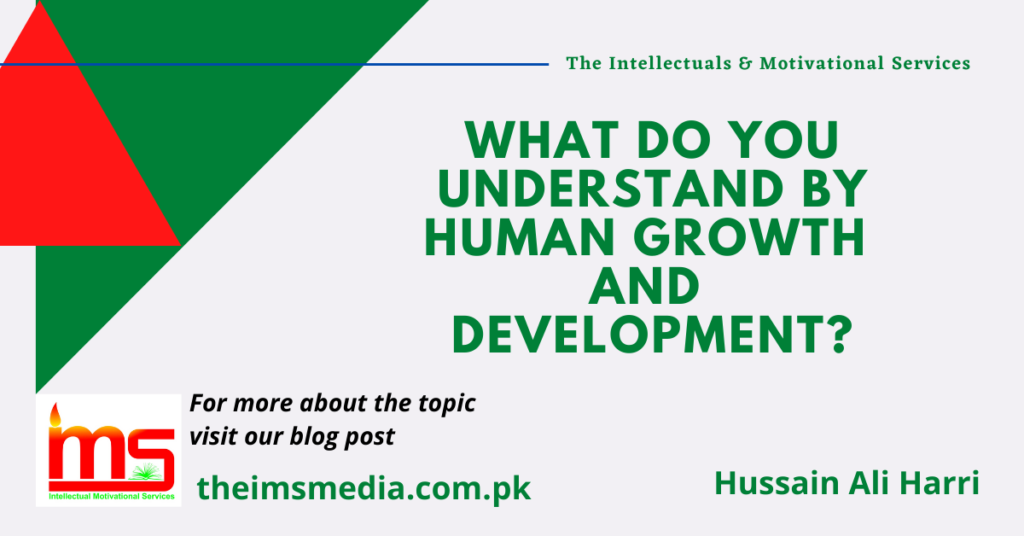
Introduction:
The term “growth and development” mean the changes that take place in human behavior particularly in a child after concept right from the womb to womb. Growth is external in nature. It can be directly measured. It means increase and or addition in size and weight its chief concern is with the physical aspects of an individual. Growth occurs in particular age.
On the other hand, developments internal in nature, it can only be felt. It means working of the internal organs and their functions. Growth and development reinter-related. Both are interdependent and influence each other .When growth stops because of illness, on there is premature stoppage of growth, development is equally effected.
Principles of growth and development:
The important principles of growth and development include the following:
- Growth is continuous .The entire life span has been divided into different stages like babyhood, Early childhood
- Development can be predicted
- Growth follows pattern such as Cephalous caudal which proceed and proceed from had downward and proximal distal which proceeds from spinal cord outward.
- Development in rapid in early years of life.
- Development is regressive which is called going back in regression.
- Growth and development is cumulative .Sometimes little things add up in life an influence .There are various types of growth and development such as development and education ,mental growth and development and lingual development.
The nature of Growth and development:
Development is a series of orderly progression of changing towards the goals of materiality. Orderly refers to the arrangements of the changes. Progression refers to directionally of changes .The directions of course is towards adaptations which is conductive to survival .However growth is generally taken to mean dimensionally argumentations cellular multiplication or quantitative change in size weight and number.
Growth and development are sometimes used synonymously to differentiate b/w these two terms, growth is generally taken to quantitative in nature whereas development is qualitative. Physical development is both qualitative and quantitative and implies increasing capacities and abilities maturing functional improvement and progress towards higher levels of effectiveness and potentiality.
Five important characteristics of human growth and development are discussed be:
Development is continuous:
Development is continuous process, it may be covered .Diseases or severe malnutrition may halt its continuity for a time.
Development is orderly:
It proceeds from general to specific responses.
Development id sequential:
It follow a pattern for example whereas steps follow one another e.g. puberty before full physical stature.
Development is unique:
Children’s differ individually with regards to their time schedule.
Development is inter-related:
Although three type of development i.e. mental, social and emotional are interrelated. Social development is nothing but a reference of emotional development.
Two principles of development and growth:
In addition to these general characteristics growth and development are based on the following two principles.
Interaction of heredity and environment:
The individual is the product of interaction b/w his heredity and environment. Though the genes are important in determining the rate and quality of its growth and development, his social, cultural environment. Physical surrounding and the emotional climates have their own impact.
Interaction of maturation and learning;
Growth and development occur as a result of both maturation and learning. Maturation refers to changes in a development organisms due to unfolding and ripening of abilities characteristics, traits and potentialities present at birth.
Growth is very significant and includes in changes in skeletal dimensions, height and weight, body proportions and teeth. Motor development is of strength, speed, precisions in the use of speech organs, hands, fingers, arms and legs and other bodily muscles motor behavior serves as a vehicles for the child’s social contracts. Growth is an ability to perform motor acts seems to reach its maximum at the age of 14 year for girls and 17 years for boys with increased strength boys develops competitive athletic skills whereas girls concentrate their efforts in developing skills like dancing, painting etc. The superiority of the boys in some motor performance seems to be due to in born factors and cultural pressures.
Developing psychologists are not only persons interested in the growth and development of human organisms.
Presented by: Hussain Ali Harri
Prepared by: Meher Bano Harri
Important Note: This material is written for our academic notes which are published keeping in view the needs of other students.
This means that the content should be credited and the website referenced so that copyright principles are adhered to.
This material is in accordance with the curriculum of Allama Iqbal Open University Level M.Ed. So visit the University website for further study.
Full details of this content can be obtained by contacting us.


I may need your help. I tried many ways but couldn’t solve it, but after reading your article, I think you have a way to help me. I’m looking forward for your reply. Thanks.
Please contact our official email or contact us. I will try my best as soon as possible thanks
Thanks for sharing. I read many of your blog posts, cool, your blog is very good.
Thank you for your interest and valuable advice. We hope you will continue to share your insights and feedback as we move forward with our research. Since our articles are based on thorough research and verified facts, the publishing process can take some time. To stay updated, we invite you to subscribe to our blog newsletter, so you’ll receive our latest posts as soon as they’re available. For further information or guidance, feel free to reach out to us via our official email.
theims.media@gmail.com
Thank you!
Your article helped me a lot, is there any more related content? Thanks!
Thank you for your interest and valuable advice. We hope you will continue to share your insights and feedback as we move forward with our research. Since our articles are based on thorough research and verified facts, the publishing process can take some time. To stay updated, we invite you to subscribe to our blog newsletter, so you’ll receive our latest posts as soon as they’re available. For further information or guidance, feel free to reach out to us via our official email.
theims.media@gmail.com
Thank you!
You helped me a lot with this post. I love the subject and I hope you continue to write excellent articles like this.
Thank you so much for your kind words! I’m thrilled to hear that you found the post helpful and enjoyable. I appreciate your support and will definitely continue to write more articles on this subject. If you have any specific topics or questions in mind, feel free to share them!
You’ve the most impressive websites.
Thank you for your kind words! We strive to create user-friendly and visually appealing websites that meet the needs of our users. If you have any specific features or ideas in mind, feel free to share, and we would be happy to assist you!
Thank you for your help and this post. It’s been great.
You’re very welcome! I’m glad to hear that you found the post helpful. If you have any more questions or need further assistance, feel free to ask!
Please tell me more about your excellent articles
I appreciate your interest in my articles! Each piece is crafted to provide insightful and engaging content on various topics. I aim to combine thorough research with a clear writing style, making complex subjects accessible to readers. The articles often include real-world examples, expert opinions, and practical tips to enhance understanding and applicability. If there are specific topics you’re curious about, I’d be happy to provide more details or recommend particular articles!
You’ve been great to me. Thank you!
You’re very welcome! I’m glad to hear that you’ve found my assistance helpful. If you have any more questions or need further support, feel free to ask!
You helped me a lot by posting this article and I love what I’m learning.
I’m really glad to hear that the article has been helpful to you! It’s great that you’re enjoying the learning process. If you have any questions or need further information on the topic, feel free to ask!
Can you be more specific about the content of your article? After reading it, I still have some doubts. Hope you can help me.
Of course! I’d be happy to clarify the content of my article for you. Please let me know which specific sections or points you’re unsure about, and I’ll provide more detailed explanations or examples to help clarify any doubts you have. Your understanding is important, and I’m here to assist you!
You’ve been great to me. Thank you!
You’re very welcome! I’m glad to hear that you’ve found my assistance helpful. If you have any more questions or need further support, feel free to ask!
Your article helped me a lot, is there any more related content? Thanks!
Dear readers, we are delighted to welcome you to our website. Your visit is greatly appreciated. Thank you for your support and positive feedback. We look forward to your continued encouragement. Thank you.
Thank you for your sharing. I am worried that I lack creative ideas. It is your article that makes me full of hope. Thank you. But, I have a question, can you help me?
Yes Please. Dear readers, we are delighted to welcome you to our website. Your visit is greatly appreciated. Thank you for your support and positive feedback. We look forward to your continued encouragement. Thank you.
Thank you for your sharing. I am worried that I lack creative ideas. It is your article that makes me full of hope. Thank you. But, I have a question, can you help me?
Dear readers, we are glad to have you on our website. Your visit is warmly welcomed. We appreciate your encouragement and positive feedback, and we hope that you will continue to support us in this way. thanks
Good write-up, I抦 regular visitor of one抯 site, maintain up the nice operate, and It’s going to be a regular visitor for a lengthy time.
Dear readers, we are glad to have you on our website. Your visit is warmly welcomed. We appreciate your encouragement and positive feedback, and we hope that you will continue to support us in this way. thanks
Thanks for sharing. I read many of your blog posts, cool, your blog is very good.
Welcome!
We extend a warm welcome to all our esteemed readers and visitors. Your presence on our blog is not merely appreciated; it is invaluable. We sincerely appreciate your engagement and are eager to hear your useful advice as we strive for excellence in our content. In our pursuit of continuous improvement, we recognize the importance of constructive feedback. Our primary goal is to provide informative and engaging posts that resonate with our audience. To that end, we invite you to subscribe to our blog. By doing so, you will be among the first to receive new content and updates, ensuring a more immersive and enriching experience. Moreover, your insights and suggestions are crucial in shaping the direction of our posts. We genuinely believe collaboration with our readers can enhance quality and more relevant topics. As we navigate the evolving landscape of information and discourse, your guidance will help us refine our approach and better serve your interests. Thank you for considering our invitation to subscribe and contribute your thoughts. Together, we can foster a community of knowledge and shared experience, amplifying the impact of our work. We look forward to your continued support and engagement. Subscribe our News Latter